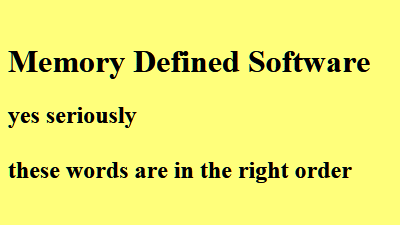SandForce shows x2 SSD
controller
Editor:- October 7, 2010 - SandForce
today
announced
availability of its next generation
SF-2000
family SSD processors - for oems designing
SAS 3 class (6Gbps)
enterprise
acceleration SSDs.
The SF-2000 supports 500MB/s sequential R/W,
60,000 sustained random IOPS, wire speed encryption, end to end
data integrity checks
and industrial temperature operation in a
skinny flash
SSD architecture.
Also new in this controller generation is support
for sector sizes additional to 512-bytes e.g., 520, 524, 528, 4K, etc., with
Data Integrity Field (DIF) for true enterprise-class SAS drive behavior and
performance.
Editor's comments:- one simple way of looking at
the SF-2000 would be as an incremental x2 version of what SandForce has
done before - which also demonstrates that the glass ceiling for their
architecture is much higher than some people might have thought.
In a
briefing yesterday I learned a lot more about the new chip and got answers from
SandForce to a bunch of technology and marketing questions. I'll post these in
more detail in a special article on the
SSD controllers page
tomorrow.
Samsung supplies 3.5" SATA SSDs to EMC
Editor:-
October 7, 2010 - Samsung
said today it's shipping 200GB
3.5" SATA SLC
SSDs to EMC.
Sequential
R/W speeds are 260MB/s and 245MB/s respectively. R/W
IOPS are
47,000 and 29,000. The new Samsung SSDs have an 'end-to-end
data integrity'
function and encryption.
Gartner predicts
worldwide SSD units and revenues for
enterprise
application will grow to 6.3 million units and $3.6 billion in 2014.
Editor's
comments:- in a classic article (2004) -
SATA Raids
the Datacenter - Steve Gardner
(who was Director, Product Marketing at
Engenio) laid to
rest user fears that SATA hard
drives weren't good enough to use in enterprise apps.
Today as we
know all too well
there's a much bigger spread of characteristics (good and bad) in
SATA SSDs. Pick the
right product and you're delighted. Pick the wrong one and
say goodbye to that raise
or your new SSD driven
startup.
Datacenter
users are offered plenty of clues about the type of
SSD animal
locked in those removable modules but whether they have the
knowledge to
interpret them correctly is another matter. Although EMC is a follower - rather
than a leader of SSD technologies - the company's reputation for paying strict
attention to reliability
issues means this is a good endorsement for Samsung's enterprise SSDs. Only time
will tell if this confidence was well placed.
the top 20 SSD companies in Q3 2010
Editor:- October
7, 2010 -StorageSearch.com
published the 14th
quarterly edition of the
Top SSD OEMs.
The
popular list ranks the top 20 SSD companies by search volume in the quarter
ending September 30, 2010 - and is an indicator of future business success
based on the world's best SSD market focus group. ...read the article
WD's new 3 TB USB 3 HDD
Editor:- October 5, 2010 -
Western Digital
today introduced the -My
Book Essential (approx $250) - an external 3TB
USB 3 (consumer)
hard drive, with up
to 150MB/s throughput.
InfiniBand option doubles speed of RamSan-630 (3U SLC SSD)
Editor:-
October 4, 2010 -Texas
Memory Systems today
announced a
Quad Data Rate InfiniBand
card interface option for its
RamSan-630 3U SSD - which
effectively doubles the
IOPS to 1
Million (compared to the performance previously obtainable with the
fibre-channel) connection
option.
SSD battle of the form factors - update
Editor:-
October 3, 2010 - in September (for the 12th straight month in a row)
PCIe SSDs maintained
their lead over 2.5"
SSDs in the battle of the form factors for supremacy in the
enterprise SSD
server acceleration market - with 48% higher search volume by
readers of StorageSearch.com.
Traditionally
most end-users have purchased their
server acceleration
SSDs as
rackmounts rather than as modules and the ratio of SSD readers searching
for SSD rackmounts has not changed in the past year. But the search data
points towards a shift in the
SSD architectures
inside those racks within the segment I call "open" (implemented
by arrays of COTS SSDs) with a bigger slice going to arrays of PCIe SSDs.
To put it crudely - when it comes to vanilla open rackmount
accelerator SSDs (as opposed to application specific or proprietary rackmount
SSDs) the market will lean more towards SSD boxes with
Fusion-io (cards)
inside than STEC (2.5"
modules) inside.
But at sometime in the next several years I expect
2.5" SSDs to once again become the #1 form factor for server
acceleration SSDs. This reordering will come from the need to simplify the
replacement of faulty SSD modules (they may be more
reliable than
HDDs but they will
still fail) combined with the standardization of PCIe connection in a
SAS form factor - like
we're seeing now in some 3.5" SSD products from
OCZ) - and the emergence of
a new market for bulk storage
backup SSDs. (See also
2.5" NVMe SSDs.)
All
this
SSD clairvoyance
extrapolated from just a few (million) stats? - Next week I'll be publishing
the 14th quarterly ranking of the
top 10 SSD oems.
|
| ......................................................................................................................... |
 | |
 |
| .. |
 |
| SSD jargon - explained |
Do you understand all the clues
in
the solid state drive headlines?
This article will help. | |
| . |
| SSDs - the big picture |
| Editor:-
StorageSearch.com was the
world's 1st publication to provide continuous editorial coverage and analysis
of SSDs (in 1998) and since then we've led the market through many interesting
and confusing times. |
 |
If you often find yourself
explaining to your VC, lawyer or non technical BBQ guests why you spend so
much time immersed in SSD web pages - and need a single, simple, non very
technical reference to suggest - this may be the link they need. | | | |
| . |
 |
. |
 |
|
| |






